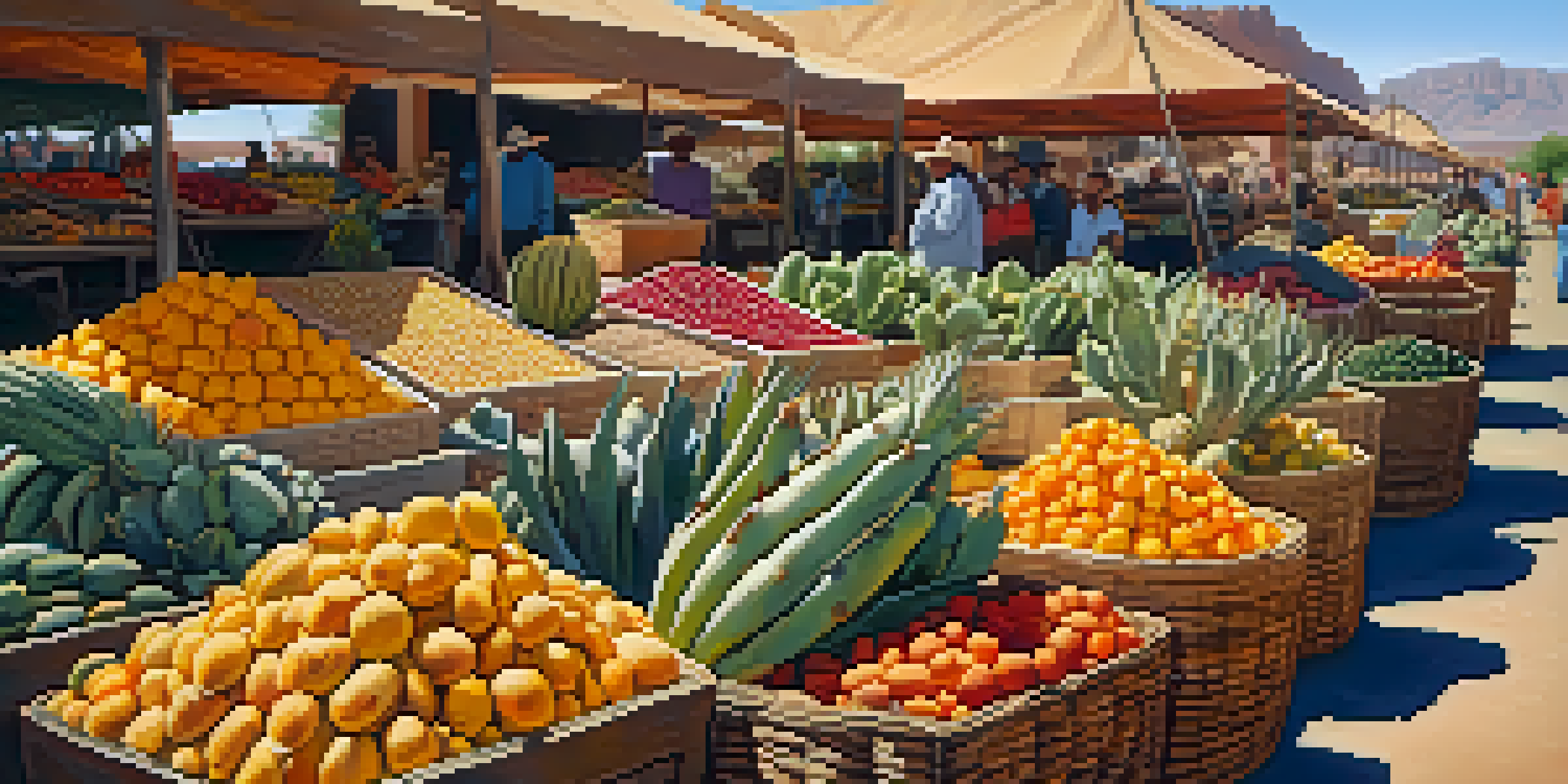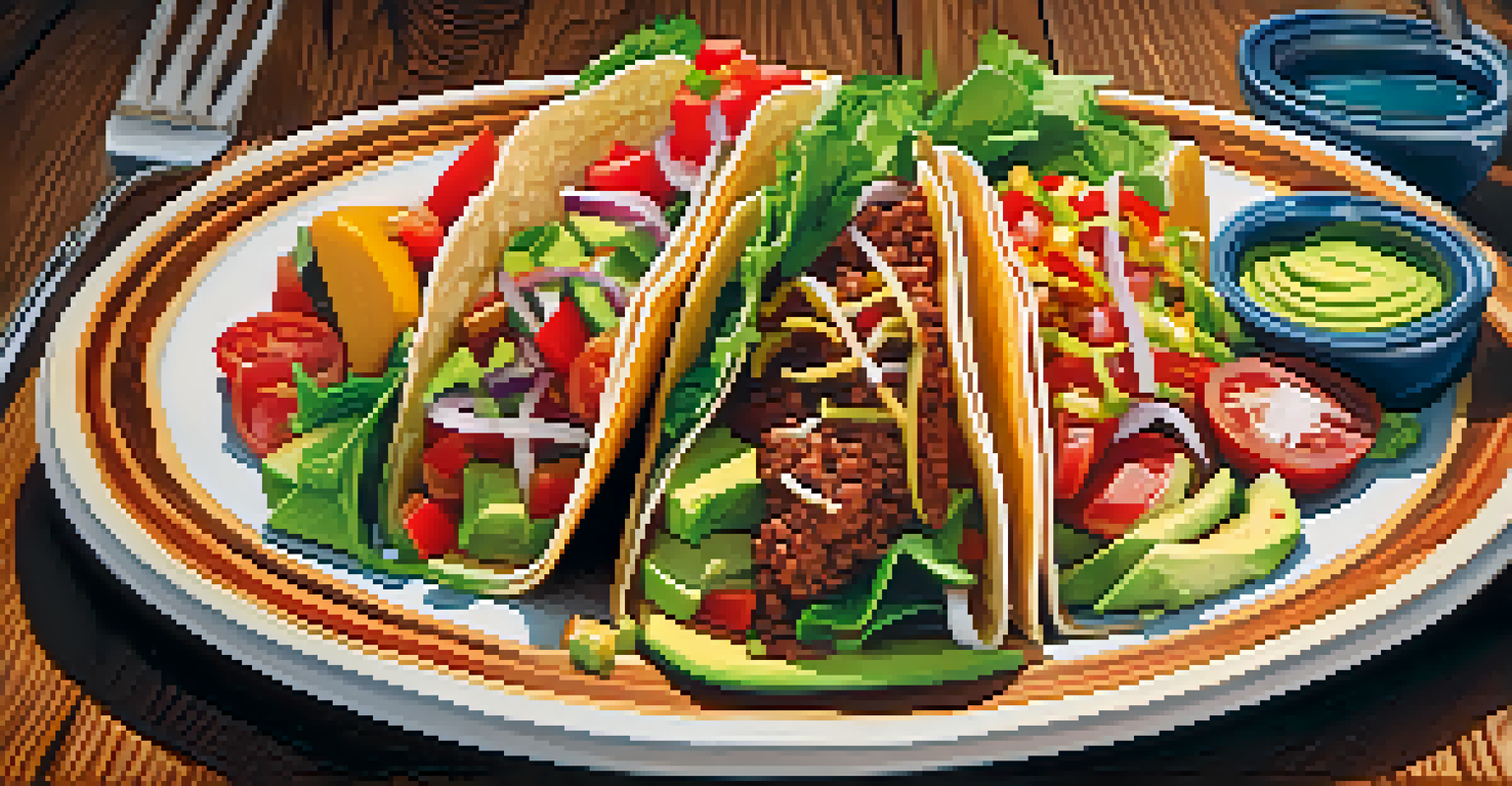The Role of Indigenous Food Practices in Arizona's Cuisine

Understanding Indigenous Food Practices in Arizona
Indigenous food practices in Arizona are deeply rooted in cultural traditions and sustainability. These practices date back thousands of years and are a testament to the ingenuity of Native American tribes in adapting to the desert environment. Traditional knowledge passed down through generations plays a crucial role in how foods are cultivated, gathered, and prepared.
Food is a central part of our culture, and it connects us to our ancestors and the land.
Many Indigenous groups, such as the Navajo and Hopi, harness the natural resources available to them, emphasizing a strong connection to the land. For instance, they grow crops like corn, beans, and squash—often referred to as the 'Three Sisters'—which not only provide nutrition but also promote ecological balance. This holistic approach to food reflects a broader worldview that prioritizes harmony with nature.
By understanding these practices, we can appreciate how they influence modern Arizona cuisine, blending traditional flavors with contemporary cooking methods. This rich history of food provides a unique lens through which to explore the culinary landscape of the state.
Key Ingredients in Indigenous Arizona Cuisine
Indigenous cuisine in Arizona is characterized by a variety of unique ingredients that are integral to traditional dishes. Native foods like prickly pear, mesquite, and saguaro cactus fruit add distinct flavors and nutritional benefits. Each ingredient not only has culinary value but also cultural significance, often tied to rituals and celebrations.

Prickly pear, for example, is not just a tasty fruit; it carries historical importance for many tribes as a vital food source. Additionally, mesquite flour, made from the pods of the mesquite tree, is a nutritious alternative for baking and cooking, showcasing the adaptability of Indigenous practices. These ingredients highlight the diversity and richness of local ecosystems, promoting a farm-to-table approach long before it became a trend.
Cultural Roots of Indigenous Foods
Indigenous food practices in Arizona are grounded in cultural traditions and sustainability, showcasing a deep connection to the land.
Incorporating these Indigenous ingredients into modern cuisine not only elevates dishes but also honors the traditions and stories behind them. Chefs and home cooks alike are increasingly recognizing the value of these ingredients in creating a more authentic culinary experience.
Traditional Cooking Methods and Techniques
Cooking methods among Indigenous groups in Arizona are as diverse as the tribes themselves, reflecting their unique histories and environments. Traditional techniques include roasting, boiling, and baking using natural materials like clay and stone. For instance, the Hopi often use an earthen oven, known as a 'kachina,' to cook their famous piki bread, a thin, flatbread made from blue cornmeal.
Indigenous food practices are not just about nutrition; they are about identity, community, and sustainability.
These methods not only enhance the flavors of the ingredients but also connect the cook to their ancestors and cultural heritage. The use of natural heat sources and local materials exemplifies a profound respect for the environment, showcasing sustainability at its core. This commitment to traditional practices has been a guiding principle for many Indigenous communities.
As modern chefs seek to incorporate these techniques into their cooking, they are not just reviving ancient practices but also fostering a deeper appreciation for the stories behind each method. This blending of old and new creates a culinary dialogue that celebrates Arizona's rich food heritage.
The Influence of Seasonal Changes on Food Practices
Seasonality plays a significant role in Indigenous food practices, dictating what foods are harvested, gathered, or consumed throughout the year. Many tribes in Arizona follow a seasonal calendar that outlines the optimal times for planting, harvesting, and hunting. This cyclical rhythm aligns with the natural world and fosters a deep understanding of local ecosystems.
For example, summer is often the time for gathering wild herbs and fruits, while winter may focus on preserving foods like dried corn and beans. This seasonal awareness not only contributes to a varied diet but also reinforces the importance of sustainability and resource management. By respecting the land's cycles, Indigenous peoples ensure the health of their communities and the environment.
Seasonality Shapes Food Practices
Seasonal changes significantly influence Indigenous food practices, guiding the harvesting and consumption of various foods throughout the year.
Incorporating seasonal ingredients into modern recipes can enhance flavor while honoring these traditional practices. It encourages a mindful approach to eating that connects people with the rhythms of nature and the wisdom of Indigenous cultures.
Celebratory Foods and Cultural Significance
Food plays a central role in Indigenous celebrations, often symbolizing community, identity, and spirituality. Special dishes are prepared for significant events such as weddings, harvest festivals, and ceremonies. For example, the Navajo celebrate the Blessingway ceremony with traditional dishes, emphasizing the importance of food in spiritual and cultural life.
These celebratory foods are often made with ingredients that hold specific meanings, reflecting the values and beliefs of the community. They serve not just as sustenance but as a way to express gratitude for the earth's bounty and the interconnectedness of all life. Sharing these meals strengthens community bonds and fosters a sense of belonging.
In today's culinary landscape, many chefs strive to incorporate these celebratory foods into their menus, offering diners a taste of the cultural significance behind each dish. This not only provides an opportunity to experience Indigenous cuisine but also invites a deeper understanding of the traditions that shape it.
Modern Adaptations of Indigenous Recipes
As Indigenous food practices gain recognition, many chefs are creatively adapting traditional recipes to fit modern palates. This fusion of old and new allows for the preservation of cultural heritage while also appealing to contemporary tastes. Chefs often experiment with traditional ingredients, reinventing dishes that respect their roots yet embrace innovation.
For instance, a classic dish like Navajo tacos has found its way into mainstream cuisine, with variations that include unique toppings and flavors. This not only brings awareness to Indigenous ingredients but also showcases the versatility of traditional recipes. By reimagining these dishes, chefs are playing a crucial role in keeping Indigenous culinary traditions alive.
Modern Adaptations Honor Traditions
Chefs are creatively adapting traditional Indigenous recipes to modern tastes, ensuring the preservation and appreciation of cultural heritage.
However, it is essential to approach these adaptations with respect and authenticity. Acknowledging the origins of the recipes and the communities behind them is vital in honoring the cultural significance of Indigenous cuisine, ensuring that adaptations serve both the food and the stories it carries.
The Future of Indigenous Food Practices in Arizona
Looking ahead, the future of Indigenous food practices in Arizona is promising, as more people recognize the value of these traditions. There is a growing movement among Indigenous chefs and communities to reclaim and promote their culinary heritage. This resurgence is not only about preserving traditional practices but also about addressing contemporary issues such as food sovereignty and health.
By emphasizing local ingredients and ancestral knowledge, Indigenous food practices can offer sustainable solutions to modern food systems. Initiatives aimed at educating younger generations about traditional cooking and farming methods are crucial for keeping these practices alive. This cultural revival is essential for fostering pride and identity within Indigenous communities.

As the culinary landscape continues to evolve, the integration of Indigenous food practices will likely play a vital role in shaping Arizona's cuisine. By celebrating these traditions, we can create a more inclusive and diverse culinary scene that honors the rich history of Indigenous peoples.